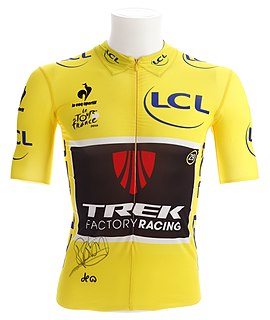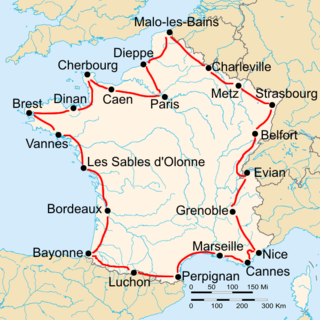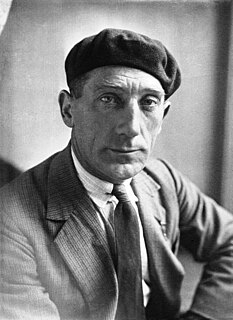Related Research Articles

The general classification is the most important classification, the one by which the winner of the Tour de France is determined. Since 1919, the leader of the general classification wears the yellow jersey.

François Faber was a Luxembourgian racing cyclist. He was born in France. He was the first foreigner to win the Tour de France in 1909, and his record of winning 5 consecutive stages still stands. He died in World War I while fighting for France. Faber was known for his long solos; he is the only rider in Tour de France history to lead solo more than 1000 km.

The 1983 Tour de France was the 70th edition of the Tour de France, run from 1 to 24 July, with 22 stages and a prologue covering a total distance of 3,809 km (2,367 mi) The race was won by French rider Laurent Fignon. Sean Kelly of Ireland won the points classification, and Lucien Van Impe of Belgium won the mountains classification.

The 1907 Tour de France was the fifth running of the annual Tour de France, one of cycling's Grand Tours. From 8 July to 4 August, the 93 cyclists cycled 4488 km (2,788 mi) in fourteen stages around France. The winner, Lucien Petit-Breton, completed the race at an average speed of 28.47 km/h (17.69 mi/h). For the first time, climbs in the Western Alps were included in the Tour de France. The race was dominated at the start by Émile Georget, who won five of the first eight stages. In the ninth stage, he borrowed a bicycle from a befriended rider after his own broke. This was against the rules; initially he received only a small penalty and his main competitors left the race out of protest. Georget's penalty was then increased and Lucien Petit-Breton became the new leader. Petit-Breton won two of the remaining stages and the overall victory of the Tour.

The 1929 Tour de France was the 23rd edition of the Tour de France, taking place from 30 June to 28 July. It consisted of 22 stages over 5,286 km (3,285 mi).

The 1926 Tour de France was the 20th edition of the Tour de France, taking place from 20 June to 18 July. It consisted of 17 stages with a total distance of 5745 km, ridden at an average speed of 24.064 km/h.

The 1908 Tour de France was the sixth running of the annual Tour de France, one of cycling's Grand Tours. It was organised by the newspaper L'Auto, and took place between 13 July and 9 August. The Tour was split in 14 stages, with a total distance of 4,497 kilometres (2,794 mi).

The 1909 Tour de France was the seventh edition of the Tour de France, taking place from 5 July to 1 August. It consisted of 14 stages over 4,497 kilometres (2,794 mi), ridden at an average 28.658 km/h. The results were computed by points accorded finishing positions on each stage, the rider with fewest points at the end of the race winning the race. The stages were approximately the same as in the 1907 and 1908 Tour de France.

The 1919 Tour de France was the 13th edition of the Tour de France, taking place from 29 June to 27 July over a total distance of 5,560 kilometres (3,450 mi). It was the first Tour de France after World War I, and was won by Firmin Lambot. Following the tenth stage, the yellow jersey, given to the leader of the general classification, was introduced, and first worn by Eugène Christophe.

Eugène Christophe was a French road bicycle racer and pioneer of cyclo-cross. He was a professional from 1904 until 1926. In 1919 he became the first rider to wear the yellow jersey of the Tour de France.

The 1925 Tour de France was the 19th edition of the Tour de France. It was held from 21 June to 19 July, over 5,440 km (3,380 mi) in 18 stages. Italian Ottavio Bottecchia successfully defended his 1924 victory to win his second consecutive Tour. Only 49 of the 130 participants finished the course.

The 1928 Tour de France was the 22nd edition of the Tour de France, taking place from 17 June to 15 July. It consisted of 22 stages over 5,376 km (3,340 mi).

Peugeot team was a French professional cycling team that promoted and rode Peugeot racing bikes.

Alcyon was a French professional cycling team that was active from 1905 to 1959, and returned in 1961 and 1962. It was started by Alcyon, a French bicycle, automobile and motorcycle manufacturer.

Victor Fontan was a French cyclist who led the 1929 Tour de France but dropped out after knocking at doors at night to ask for another bicycle. His plight led to a change of rules to prevent its happening again. He was also one of three riders who all wore the yellow jersey of leadership on the same day, the only time it has happened.

Tom Simpson was a British professional cyclist, one of Britain's most successful of all time. At the time of the 1967 Tour de France, he was the undisputed leader of the British team. In the 13th stage of that race, he collapsed and died during the ascent of Mont Ventoux.
References
- ↑ McGann, Bill; McGann, Carol (2006). The Story of the Tour de France. Dog Ear Publishing. pp. 51–56. ISBN 1-59858-180-5 . Retrieved 8 June 2009.
- ↑ "Cycles Automoto: Setting the Standard". EBykr. Retrieved 2007-11-04.
- ↑ "Norbert Peugeot: The inventor of the training camp". Cyclingnews.com. Retrieved 2007-11-04.
- ↑ "Firmin Lambot (Belgique)". Memoire du cyclisme.net. Archived from the original on 2007-10-18. Retrieved 2007-11-12.
- ↑ Tom James (15 August 2003). "1925: Once again Bottecchia" . Retrieved 10 June 2009.